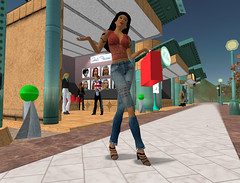I came to hear about Second Life [1] after reading about it in a blog [1] by Greg Sterling, former editor and director of the Kelsey Group’s Interactive Local Media program. If you haven’t heard about it, read about it in this article [2]. Second Life is basically a virtual reality (“VR”) platform (or, “world”, or “metaverse” if you will). People go in there, buy VR property or other objects, and interact with thousands of other participants.

“So what?” you might say. So, how does this differ from World of Warcraft, the Sims Online, or EverQuest?
First, there’s no goal to Second Life, per se — users just go into the thing, hang out, and interact with other users and the virtual environments. Second, users can own property in this world, and they can sell the property for real money in the real world! (Contrast with EverQuest, where they’ve actively worked to keep people from selling characters on eBay and such.) Finally, people have begun marketing through this new media — like gangbusters!
 [3]
[3]
Copyright 2006, Linden Research, Inc. All Rights Reserved.
People like Anshe Chung [4] are now making hundreds of thousands of dollars per year by designing and selling the SL virtual real estate. Others are offering services like architecture, event planning, selling artworks, scripting, and even financial or legal services. Some universities are now teaching within the space, too!
 [5]Strangely enough, some science fiction authors have predicted the rise of virtual reality environments being used in these ways. Most particularly this was described with a lot of detail in Snow Crash [5], by Neal Stephenson, published first in 1992.
[5]Strangely enough, some science fiction authors have predicted the rise of virtual reality environments being used in these ways. Most particularly this was described with a lot of detail in Snow Crash [5], by Neal Stephenson, published first in 1992.
Stephenson describes a virtual world where individuals buy and sell property, and where earlier adopters who purchased property in it were able to later make a mint in the real world by selling out to mega corporations or affluent individuals. Hackers scripted special creatures and behaviours into the world, and designed fascinating architectural wonders. Rock stars would put in appearances in the VR to promote themselves and to conduct business deals.
It’s actually not too clear that Stephenson predicted something like Second Life — as Penguin Books mentions [6], Stephenson’s book actually influenced the creators and participants into pursuing this vision — this is a case where SciFi actually steered the technological development towards immitating the fiction. I’ve previously blogged [7] about how technology, the internet, and the real world have been predicted by SciFi, so chalk this one up as yet another example.
In this case, the fiction has predicted a major new paradigm where interactive marketing is concerned. Businesses and individuals are looking towards Second Life as a new medium to grab attention and promote their products and themselves. Wells Fargo Bank, Sun Microsystems, Coca-Cola, and Toyota have all started building stuff and doing stuff in Second Life as a method for marketing themselves online. In August, Susanne Vega became the first musician to perform a “live” concert in SL space, through her avatar [8].
The cool thing about this is that Second Life is evolving online marketing directly towards traditional promotional tactics found in the real world before the internet took off. Businesses wishing to derive benefit from this new media will be performing the traditional analysis used in real estate in order to locate advantageous properties where they can build their VR presence. Location, location, location!
They’ll be hiring architectural designers to fix up their place, and they’ll hire VR event planners to create happenings to attract attention. They’ll pay celebs to be their spokespersons, and they’ll buy strange sorts of advertisements all over the metaverse space, in the unlikeliest of spots. Product placement is now possible on this virtual world in a big way — possibly even more effective than it is on TV or in movies, at least while this medium is still new.
If growth in this space continues as it has been, major companies will even pay fulltime staff to manage their VR presence.
Is this a trend worth paying attention to? YES! Second Life just topped one million users [9] six days ago! That is months before their prediction of reaching one million in 2007. This trend is increasing rapidly [10]!
What’s the natural progression for this trend? Imagine online users spending more and more time in this virtual world space, instead of in chat rooms and forums and such. Imagine travelling to a building with people in it who will verbally tell you about the information you’re seeking, instead of typing a keyword into a flat page. Instead of doing your product research on a company website, you might go into their virtual store and question their virtual salesmen until you’re certain of what you want to buy. A three dimensional space is far more compelling to people.
I think that online marketing and optimization has now hit the next level with Second Life. Online marketing is no longer relegated to just those puttering about in the dark of night with esoteric twiddling about in URL rewrite mods, eigenvectors, keyword analysis, and conversion analytics. Online marketing and promotional optimization have now sprung into the third dimension with a whole new dynamism.
It’s time to relearn all the classic strategies for promotion! Start optimizing for this new media.